Management Economics: Tesco Analysis
VerifiedAdded on 2023/01/09
|8
|1585
|53
AI Summary
This report analyzes Tesco, a food retail business, in terms of its products/services, demand and market equilibrium, and price elasticity of demand. It provides a description of Tesco and its products/services, discusses the factors that affect its demand and market equilibrium, and explores the concept of price elasticity of demand. The report concludes by highlighting the importance of utilizing economic concepts and theories to analyze and improve business competitiveness.
Contribute Materials
Your contribution can guide someone’s learning journey. Share your
documents today.
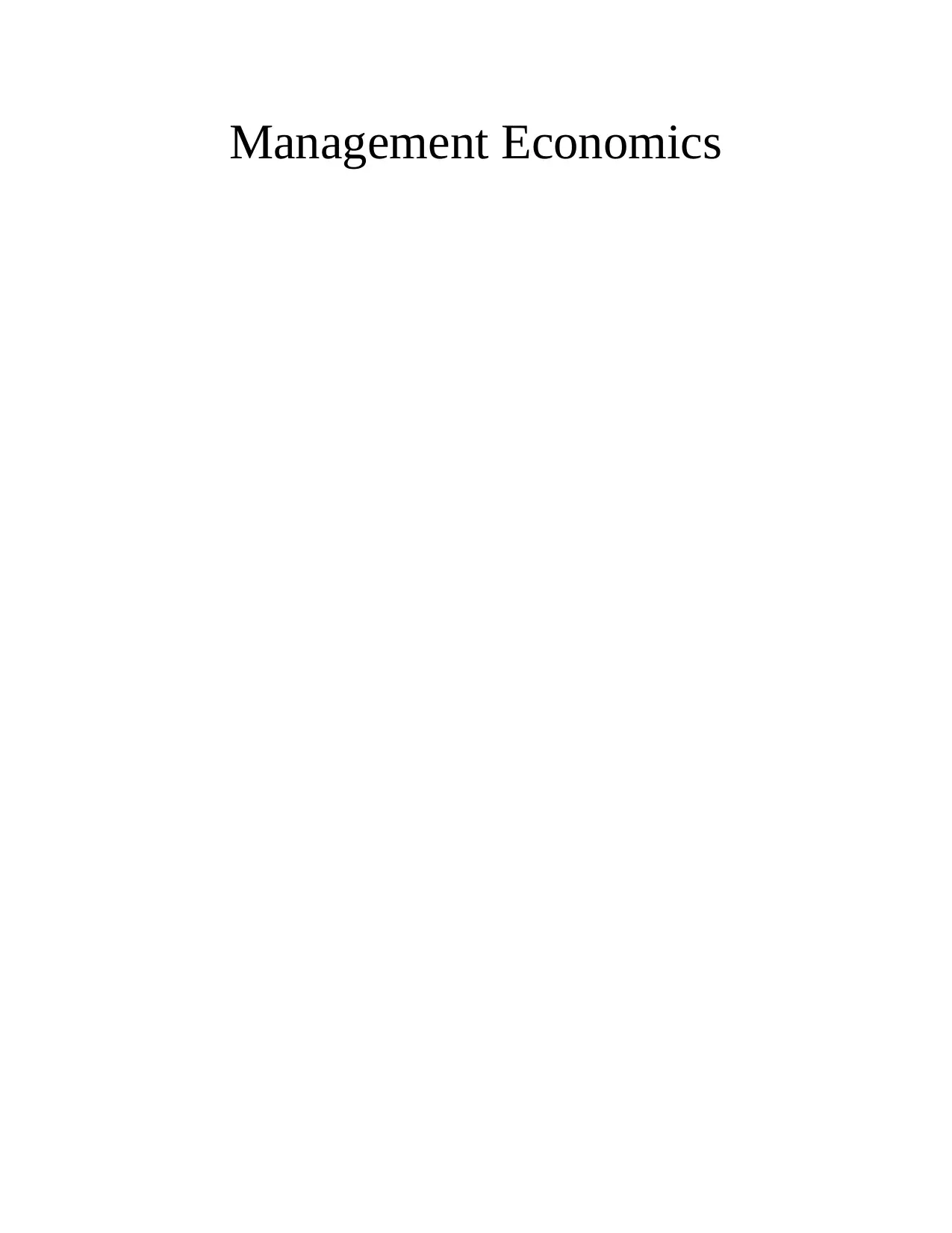
Management Economics
Secure Best Marks with AI Grader
Need help grading? Try our AI Grader for instant feedback on your assignments.
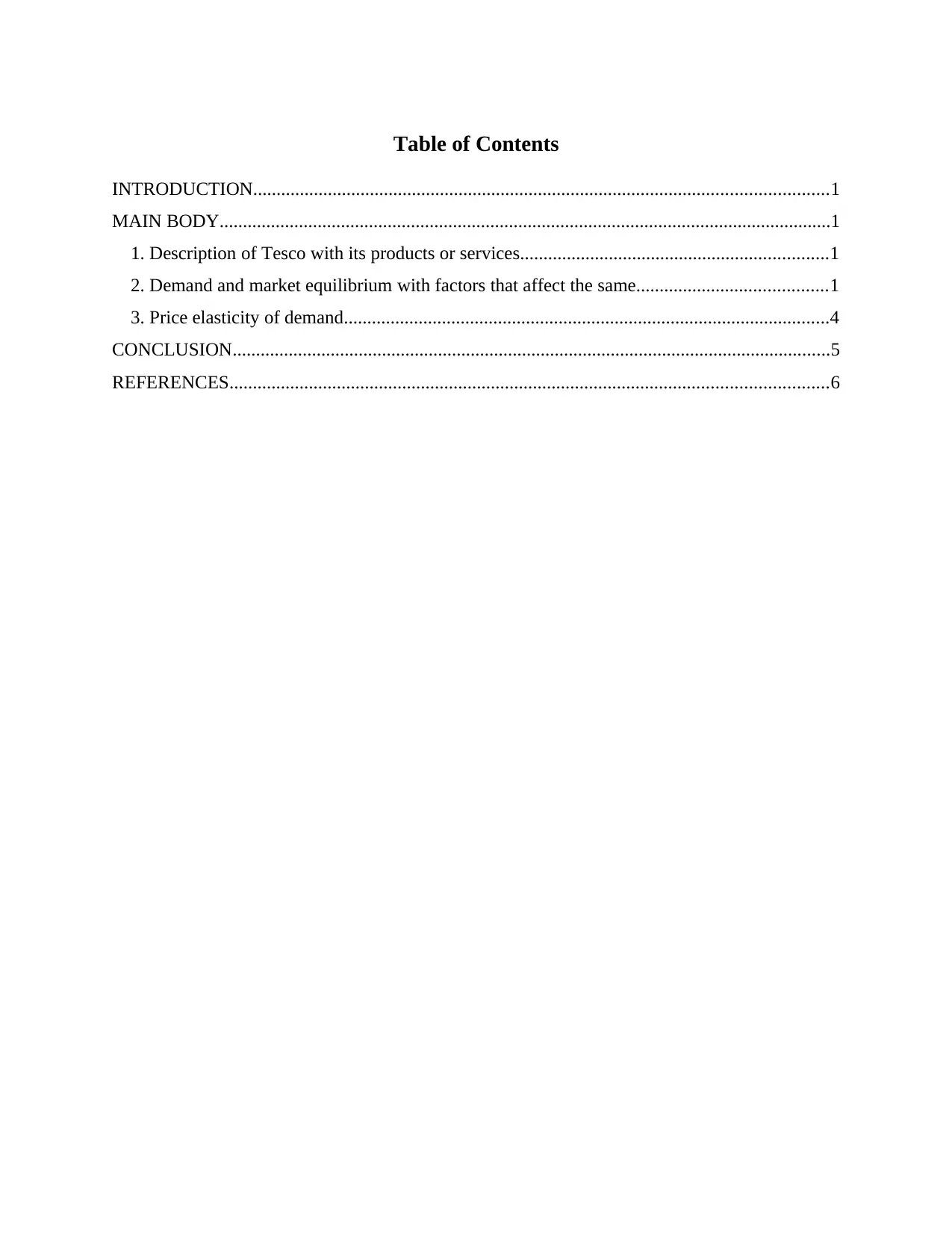
Table of Contents
INTRODUCTION...........................................................................................................................1
MAIN BODY...................................................................................................................................1
1. Description of Tesco with its products or services..................................................................1
2. Demand and market equilibrium with factors that affect the same.........................................1
3. Price elasticity of demand........................................................................................................4
CONCLUSION................................................................................................................................5
REFERENCES................................................................................................................................6
INTRODUCTION...........................................................................................................................1
MAIN BODY...................................................................................................................................1
1. Description of Tesco with its products or services..................................................................1
2. Demand and market equilibrium with factors that affect the same.........................................1
3. Price elasticity of demand........................................................................................................4
CONCLUSION................................................................................................................................5
REFERENCES................................................................................................................................6
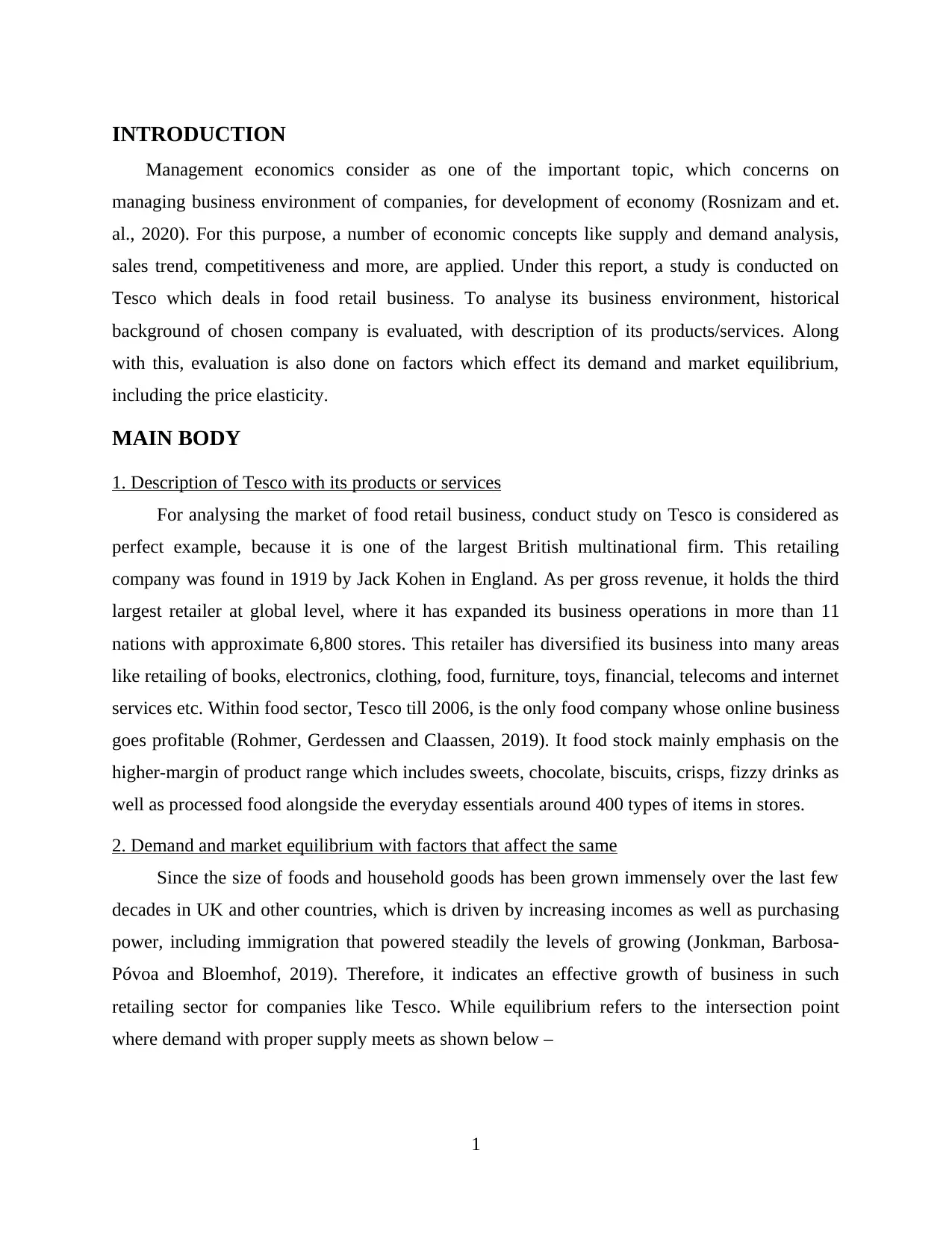
INTRODUCTION
Management economics consider as one of the important topic, which concerns on
managing business environment of companies, for development of economy (Rosnizam and et.
al., 2020). For this purpose, a number of economic concepts like supply and demand analysis,
sales trend, competitiveness and more, are applied. Under this report, a study is conducted on
Tesco which deals in food retail business. To analyse its business environment, historical
background of chosen company is evaluated, with description of its products/services. Along
with this, evaluation is also done on factors which effect its demand and market equilibrium,
including the price elasticity.
MAIN BODY
1. Description of Tesco with its products or services
For analysing the market of food retail business, conduct study on Tesco is considered as
perfect example, because it is one of the largest British multinational firm. This retailing
company was found in 1919 by Jack Kohen in England. As per gross revenue, it holds the third
largest retailer at global level, where it has expanded its business operations in more than 11
nations with approximate 6,800 stores. This retailer has diversified its business into many areas
like retailing of books, electronics, clothing, food, furniture, toys, financial, telecoms and internet
services etc. Within food sector, Tesco till 2006, is the only food company whose online business
goes profitable (Rohmer, Gerdessen and Claassen, 2019). It food stock mainly emphasis on the
higher-margin of product range which includes sweets, chocolate, biscuits, crisps, fizzy drinks as
well as processed food alongside the everyday essentials around 400 types of items in stores.
2. Demand and market equilibrium with factors that affect the same
Since the size of foods and household goods has been grown immensely over the last few
decades in UK and other countries, which is driven by increasing incomes as well as purchasing
power, including immigration that powered steadily the levels of growing (Jonkman, Barbosa-
Póvoa and Bloemhof, 2019). Therefore, it indicates an effective growth of business in such
retailing sector for companies like Tesco. While equilibrium refers to the intersection point
where demand with proper supply meets as shown below –
1
Management economics consider as one of the important topic, which concerns on
managing business environment of companies, for development of economy (Rosnizam and et.
al., 2020). For this purpose, a number of economic concepts like supply and demand analysis,
sales trend, competitiveness and more, are applied. Under this report, a study is conducted on
Tesco which deals in food retail business. To analyse its business environment, historical
background of chosen company is evaluated, with description of its products/services. Along
with this, evaluation is also done on factors which effect its demand and market equilibrium,
including the price elasticity.
MAIN BODY
1. Description of Tesco with its products or services
For analysing the market of food retail business, conduct study on Tesco is considered as
perfect example, because it is one of the largest British multinational firm. This retailing
company was found in 1919 by Jack Kohen in England. As per gross revenue, it holds the third
largest retailer at global level, where it has expanded its business operations in more than 11
nations with approximate 6,800 stores. This retailer has diversified its business into many areas
like retailing of books, electronics, clothing, food, furniture, toys, financial, telecoms and internet
services etc. Within food sector, Tesco till 2006, is the only food company whose online business
goes profitable (Rohmer, Gerdessen and Claassen, 2019). It food stock mainly emphasis on the
higher-margin of product range which includes sweets, chocolate, biscuits, crisps, fizzy drinks as
well as processed food alongside the everyday essentials around 400 types of items in stores.
2. Demand and market equilibrium with factors that affect the same
Since the size of foods and household goods has been grown immensely over the last few
decades in UK and other countries, which is driven by increasing incomes as well as purchasing
power, including immigration that powered steadily the levels of growing (Jonkman, Barbosa-
Póvoa and Bloemhof, 2019). Therefore, it indicates an effective growth of business in such
retailing sector for companies like Tesco. While equilibrium refers to the intersection point
where demand with proper supply meets as shown below –
1
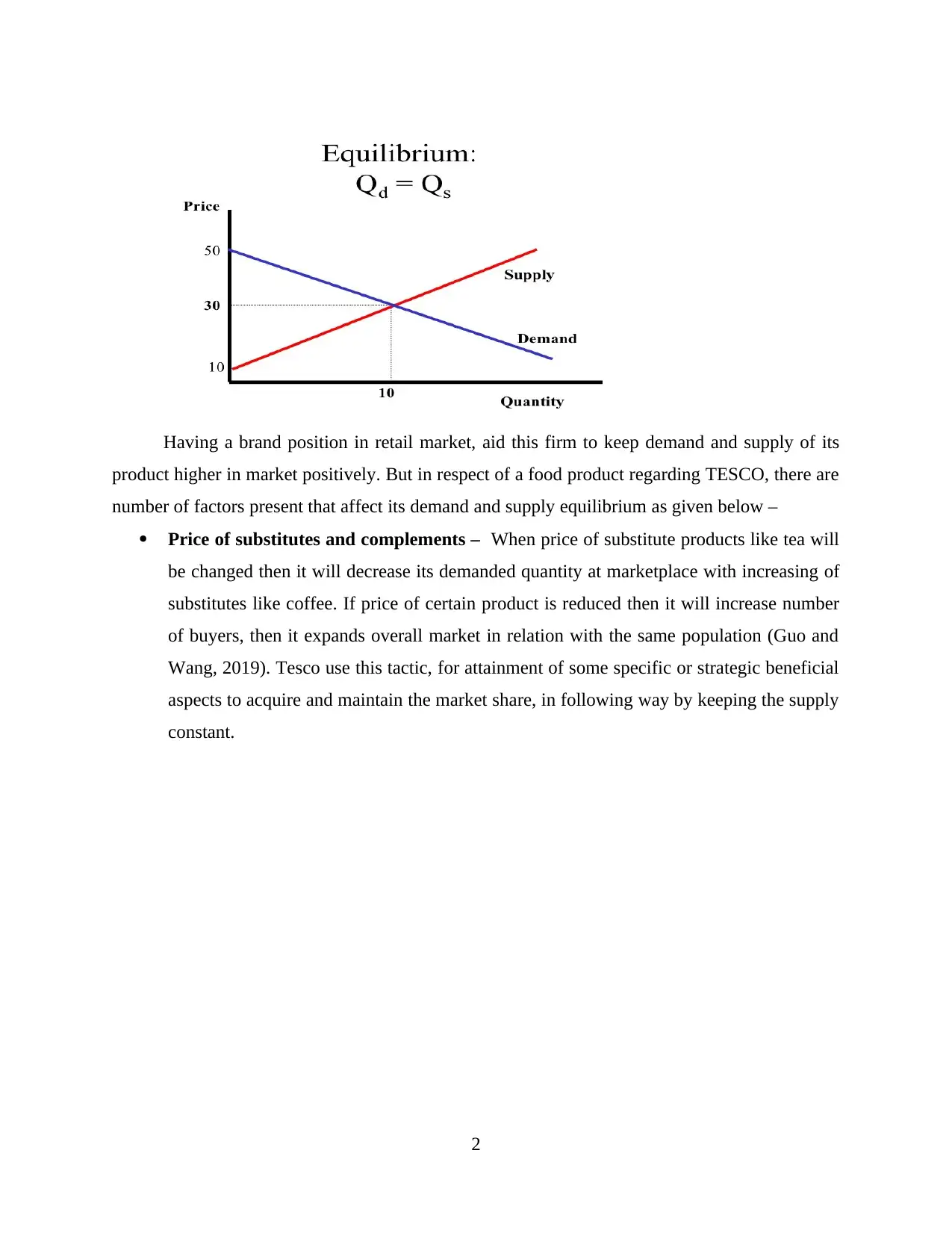
Having a brand position in retail market, aid this firm to keep demand and supply of its
product higher in market positively. But in respect of a food product regarding TESCO, there are
number of factors present that affect its demand and supply equilibrium as given below –
Price of substitutes and complements – When price of substitute products like tea will
be changed then it will decrease its demanded quantity at marketplace with increasing of
substitutes like coffee. If price of certain product is reduced then it will increase number
of buyers, then it expands overall market in relation with the same population (Guo and
Wang, 2019). Tesco use this tactic, for attainment of some specific or strategic beneficial
aspects to acquire and maintain the market share, in following way by keeping the supply
constant.
2
product higher in market positively. But in respect of a food product regarding TESCO, there are
number of factors present that affect its demand and supply equilibrium as given below –
Price of substitutes and complements – When price of substitute products like tea will
be changed then it will decrease its demanded quantity at marketplace with increasing of
substitutes like coffee. If price of certain product is reduced then it will increase number
of buyers, then it expands overall market in relation with the same population (Guo and
Wang, 2019). Tesco use this tactic, for attainment of some specific or strategic beneficial
aspects to acquire and maintain the market share, in following way by keeping the supply
constant.
2
Secure Best Marks with AI Grader
Need help grading? Try our AI Grader for instant feedback on your assignments.
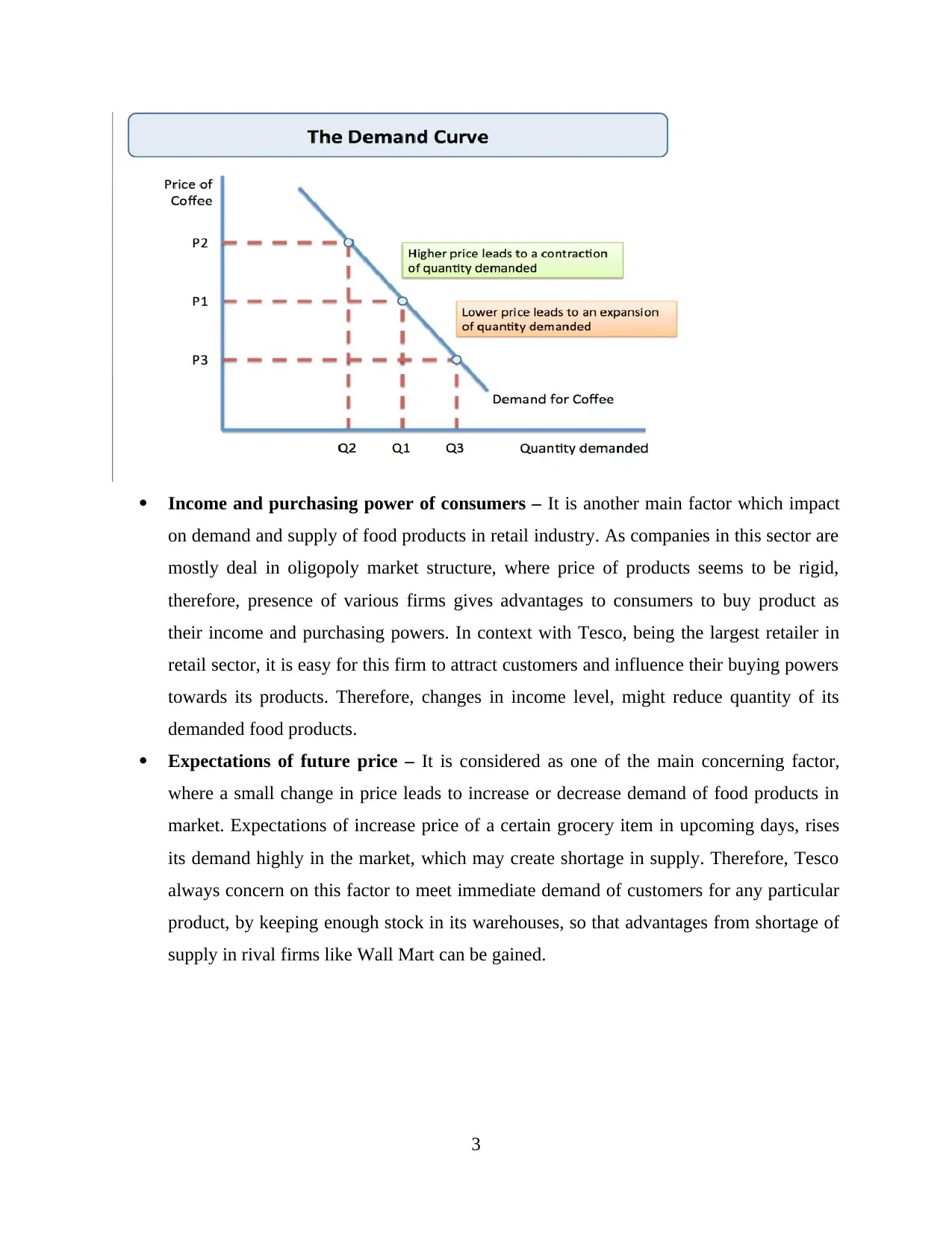
Income and purchasing power of consumers – It is another main factor which impact
on demand and supply of food products in retail industry. As companies in this sector are
mostly deal in oligopoly market structure, where price of products seems to be rigid,
therefore, presence of various firms gives advantages to consumers to buy product as
their income and purchasing powers. In context with Tesco, being the largest retailer in
retail sector, it is easy for this firm to attract customers and influence their buying powers
towards its products. Therefore, changes in income level, might reduce quantity of its
demanded food products.
Expectations of future price – It is considered as one of the main concerning factor,
where a small change in price leads to increase or decrease demand of food products in
market. Expectations of increase price of a certain grocery item in upcoming days, rises
its demand highly in the market, which may create shortage in supply. Therefore, Tesco
always concern on this factor to meet immediate demand of customers for any particular
product, by keeping enough stock in its warehouses, so that advantages from shortage of
supply in rival firms like Wall Mart can be gained.
3
on demand and supply of food products in retail industry. As companies in this sector are
mostly deal in oligopoly market structure, where price of products seems to be rigid,
therefore, presence of various firms gives advantages to consumers to buy product as
their income and purchasing powers. In context with Tesco, being the largest retailer in
retail sector, it is easy for this firm to attract customers and influence their buying powers
towards its products. Therefore, changes in income level, might reduce quantity of its
demanded food products.
Expectations of future price – It is considered as one of the main concerning factor,
where a small change in price leads to increase or decrease demand of food products in
market. Expectations of increase price of a certain grocery item in upcoming days, rises
its demand highly in the market, which may create shortage in supply. Therefore, Tesco
always concern on this factor to meet immediate demand of customers for any particular
product, by keeping enough stock in its warehouses, so that advantages from shortage of
supply in rival firms like Wall Mart can be gained.
3
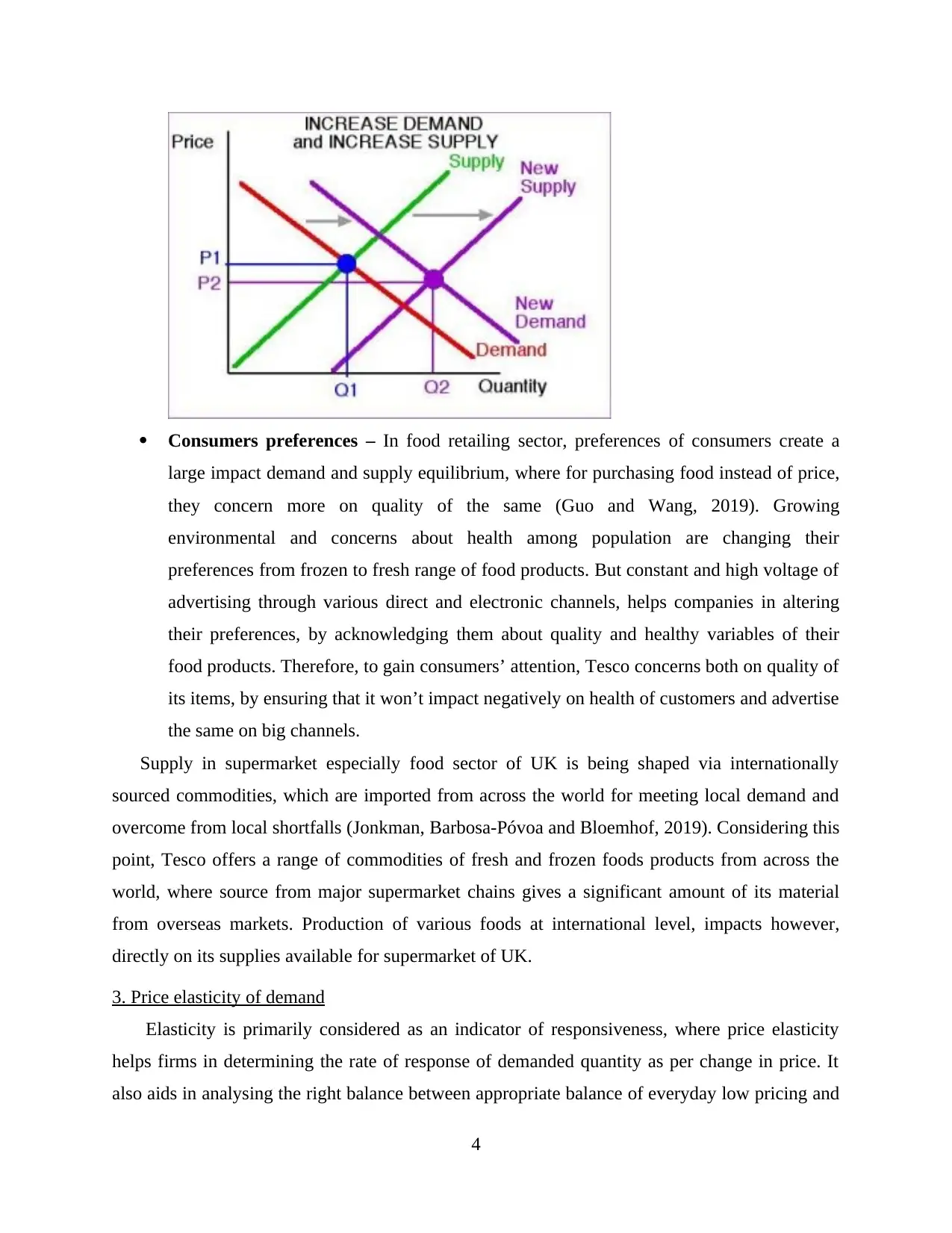
Consumers preferences – In food retailing sector, preferences of consumers create a
large impact demand and supply equilibrium, where for purchasing food instead of price,
they concern more on quality of the same (Guo and Wang, 2019). Growing
environmental and concerns about health among population are changing their
preferences from frozen to fresh range of food products. But constant and high voltage of
advertising through various direct and electronic channels, helps companies in altering
their preferences, by acknowledging them about quality and healthy variables of their
food products. Therefore, to gain consumers’ attention, Tesco concerns both on quality of
its items, by ensuring that it won’t impact negatively on health of customers and advertise
the same on big channels.
Supply in supermarket especially food sector of UK is being shaped via internationally
sourced commodities, which are imported from across the world for meeting local demand and
overcome from local shortfalls (Jonkman, Barbosa-Póvoa and Bloemhof, 2019). Considering this
point, Tesco offers a range of commodities of fresh and frozen foods products from across the
world, where source from major supermarket chains gives a significant amount of its material
from overseas markets. Production of various foods at international level, impacts however,
directly on its supplies available for supermarket of UK.
3. Price elasticity of demand
Elasticity is primarily considered as an indicator of responsiveness, where price elasticity
helps firms in determining the rate of response of demanded quantity as per change in price. It
also aids in analysing the right balance between appropriate balance of everyday low pricing and
4
large impact demand and supply equilibrium, where for purchasing food instead of price,
they concern more on quality of the same (Guo and Wang, 2019). Growing
environmental and concerns about health among population are changing their
preferences from frozen to fresh range of food products. But constant and high voltage of
advertising through various direct and electronic channels, helps companies in altering
their preferences, by acknowledging them about quality and healthy variables of their
food products. Therefore, to gain consumers’ attention, Tesco concerns both on quality of
its items, by ensuring that it won’t impact negatively on health of customers and advertise
the same on big channels.
Supply in supermarket especially food sector of UK is being shaped via internationally
sourced commodities, which are imported from across the world for meeting local demand and
overcome from local shortfalls (Jonkman, Barbosa-Póvoa and Bloemhof, 2019). Considering this
point, Tesco offers a range of commodities of fresh and frozen foods products from across the
world, where source from major supermarket chains gives a significant amount of its material
from overseas markets. Production of various foods at international level, impacts however,
directly on its supplies available for supermarket of UK.
3. Price elasticity of demand
Elasticity is primarily considered as an indicator of responsiveness, where price elasticity
helps firms in determining the rate of response of demanded quantity as per change in price. It
also aids in analysing the right balance between appropriate balance of everyday low pricing and
4
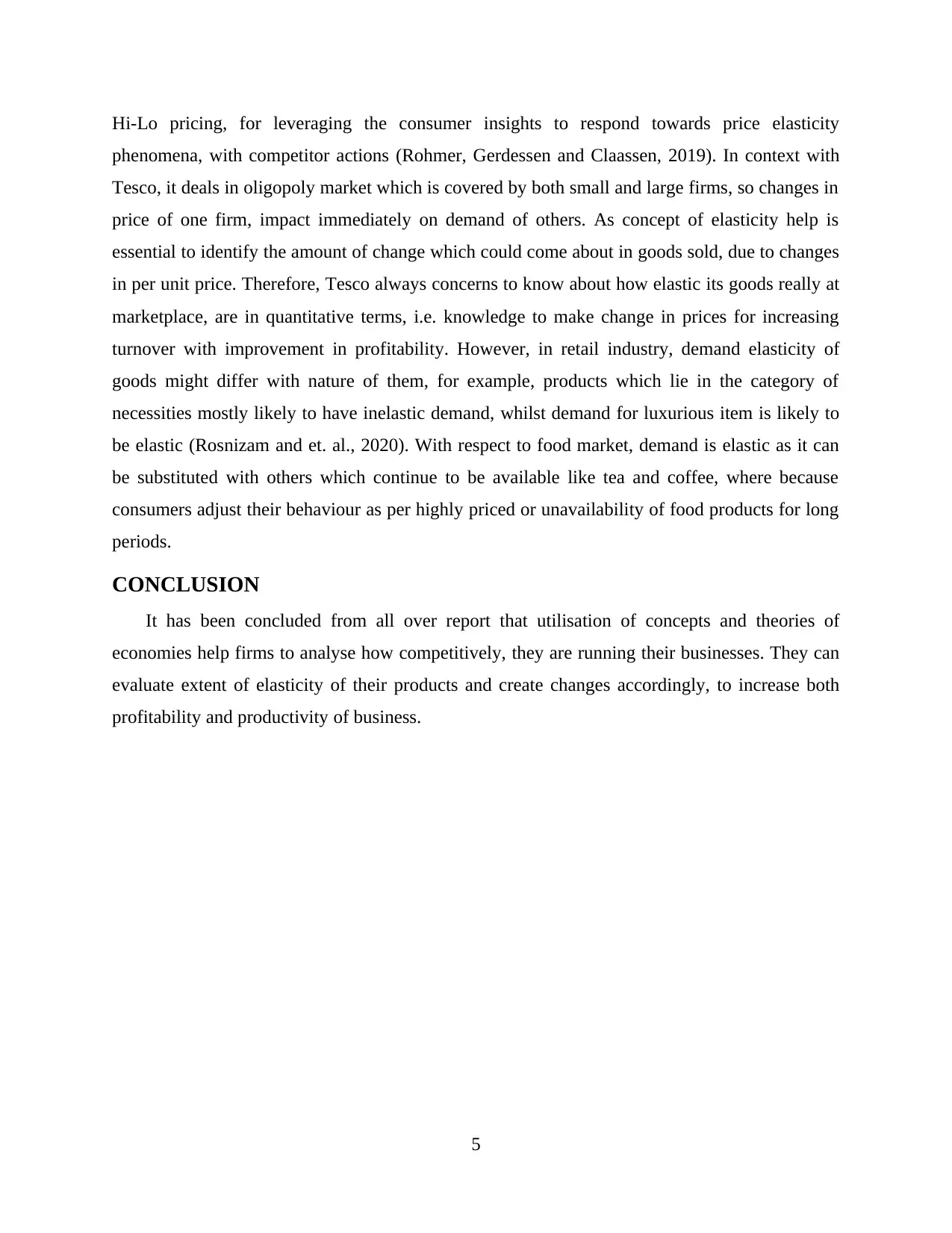
Hi-Lo pricing, for leveraging the consumer insights to respond towards price elasticity
phenomena, with competitor actions (Rohmer, Gerdessen and Claassen, 2019). In context with
Tesco, it deals in oligopoly market which is covered by both small and large firms, so changes in
price of one firm, impact immediately on demand of others. As concept of elasticity help is
essential to identify the amount of change which could come about in goods sold, due to changes
in per unit price. Therefore, Tesco always concerns to know about how elastic its goods really at
marketplace, are in quantitative terms, i.e. knowledge to make change in prices for increasing
turnover with improvement in profitability. However, in retail industry, demand elasticity of
goods might differ with nature of them, for example, products which lie in the category of
necessities mostly likely to have inelastic demand, whilst demand for luxurious item is likely to
be elastic (Rosnizam and et. al., 2020). With respect to food market, demand is elastic as it can
be substituted with others which continue to be available like tea and coffee, where because
consumers adjust their behaviour as per highly priced or unavailability of food products for long
periods.
CONCLUSION
It has been concluded from all over report that utilisation of concepts and theories of
economies help firms to analyse how competitively, they are running their businesses. They can
evaluate extent of elasticity of their products and create changes accordingly, to increase both
profitability and productivity of business.
5
phenomena, with competitor actions (Rohmer, Gerdessen and Claassen, 2019). In context with
Tesco, it deals in oligopoly market which is covered by both small and large firms, so changes in
price of one firm, impact immediately on demand of others. As concept of elasticity help is
essential to identify the amount of change which could come about in goods sold, due to changes
in per unit price. Therefore, Tesco always concerns to know about how elastic its goods really at
marketplace, are in quantitative terms, i.e. knowledge to make change in prices for increasing
turnover with improvement in profitability. However, in retail industry, demand elasticity of
goods might differ with nature of them, for example, products which lie in the category of
necessities mostly likely to have inelastic demand, whilst demand for luxurious item is likely to
be elastic (Rosnizam and et. al., 2020). With respect to food market, demand is elastic as it can
be substituted with others which continue to be available like tea and coffee, where because
consumers adjust their behaviour as per highly priced or unavailability of food products for long
periods.
CONCLUSION
It has been concluded from all over report that utilisation of concepts and theories of
economies help firms to analyse how competitively, they are running their businesses. They can
evaluate extent of elasticity of their products and create changes accordingly, to increase both
profitability and productivity of business.
5
Paraphrase This Document
Need a fresh take? Get an instant paraphrase of this document with our AI Paraphraser
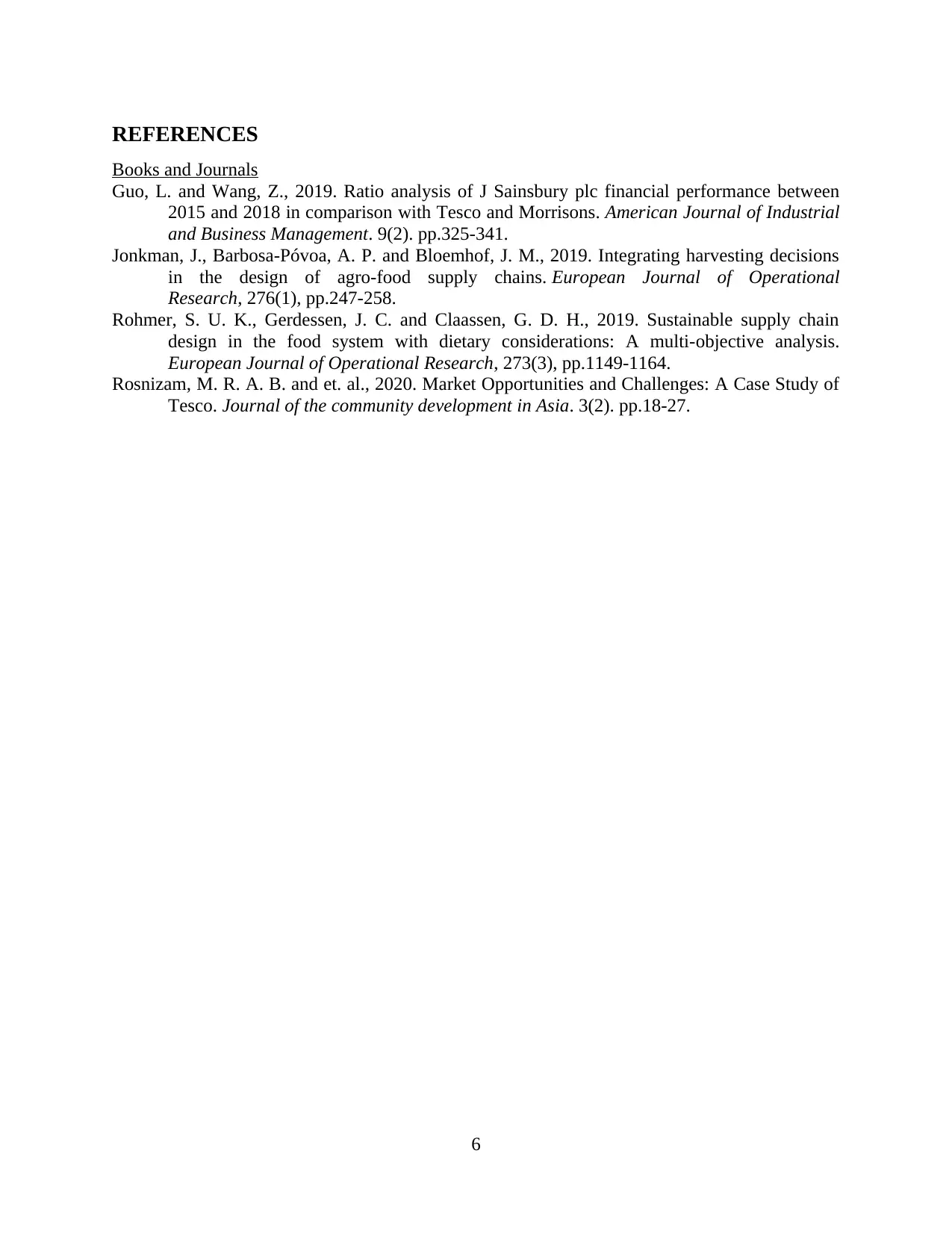
REFERENCES
Books and Journals
Guo, L. and Wang, Z., 2019. Ratio analysis of J Sainsbury plc financial performance between
2015 and 2018 in comparison with Tesco and Morrisons. American Journal of Industrial
and Business Management. 9(2). pp.325-341.
Jonkman, J., Barbosa-Póvoa, A. P. and Bloemhof, J. M., 2019. Integrating harvesting decisions
in the design of agro-food supply chains. European Journal of Operational
Research, 276(1), pp.247-258.
Rohmer, S. U. K., Gerdessen, J. C. and Claassen, G. D. H., 2019. Sustainable supply chain
design in the food system with dietary considerations: A multi-objective analysis.
European Journal of Operational Research, 273(3), pp.1149-1164.
Rosnizam, M. R. A. B. and et. al., 2020. Market Opportunities and Challenges: A Case Study of
Tesco. Journal of the community development in Asia. 3(2). pp.18-27.
6
Books and Journals
Guo, L. and Wang, Z., 2019. Ratio analysis of J Sainsbury plc financial performance between
2015 and 2018 in comparison with Tesco and Morrisons. American Journal of Industrial
and Business Management. 9(2). pp.325-341.
Jonkman, J., Barbosa-Póvoa, A. P. and Bloemhof, J. M., 2019. Integrating harvesting decisions
in the design of agro-food supply chains. European Journal of Operational
Research, 276(1), pp.247-258.
Rohmer, S. U. K., Gerdessen, J. C. and Claassen, G. D. H., 2019. Sustainable supply chain
design in the food system with dietary considerations: A multi-objective analysis.
European Journal of Operational Research, 273(3), pp.1149-1164.
Rosnizam, M. R. A. B. and et. al., 2020. Market Opportunities and Challenges: A Case Study of
Tesco. Journal of the community development in Asia. 3(2). pp.18-27.
6
1 out of 8
Related Documents
Your All-in-One AI-Powered Toolkit for Academic Success.
+13062052269
info@desklib.com
Available 24*7 on WhatsApp / Email
![[object Object]](/_next/static/media/star-bottom.7253800d.svg)
Unlock your academic potential
© 2024 | Zucol Services PVT LTD | All rights reserved.





